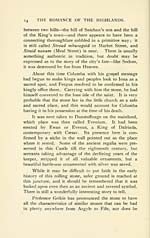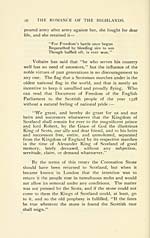Download files
Complete book:
Individual page:
Thumbnail gallery: Grid view | List view

THE CORONATION STONE. 15
see any evidence why it may not have been picked up at
Scone. But stones are very similar the world over, and
this is no argument that it may not have been picked up
on Ararat or on Sinai. If it were different from the other
stones around it, that would appear to have been a good
reason why choice should have fallen on it. Dr.
Maclagan says that "the longest migration we know of
it was from Scone to Westminster." If we accept this
theory we had as well believe that there were several
coronation stones as valuable as this one, and the question
arises, whither did these other ones, held in such great
veneration, disappear?
The stone remained in DunstafTnage until Kenneth
removed his Royal seat to Scone, in the year 834. The
glory then left this old fortress which had served as a
capital for three hundred years, but it still held the
affection which many retained for it. It is recorded that
in Bruce's time, that King held a Parliament within its
walls, at which all his legislators spoke the ancient
language. King Robert was no doubt a proficient
Gaelic scholar, attained from his association, but more
particularly from his mother, who was a Highland lady.
The stone remained in Scone (the derivation of
which would appear to be Sgain-a tabernacle) till 1296,
when it was carried to Westminster by Edward I — better
known, perhaps, as "The Hammer of the Scots."
Fordun tells that it was preserved in the Monastery of
Scone, but it doubtless had been taken frequently from
there to the Moot Hill, whence the Kings promulgated
their decrees. Evidently it formerly had — and we hope
it always will have — a religious significance.
What a wonderful history has this little country of
Scotland. No land can boast a story half so grand.
Attacked by her populous and wealthy neighbour, who
see any evidence why it may not have been picked up at
Scone. But stones are very similar the world over, and
this is no argument that it may not have been picked up
on Ararat or on Sinai. If it were different from the other
stones around it, that would appear to have been a good
reason why choice should have fallen on it. Dr.
Maclagan says that "the longest migration we know of
it was from Scone to Westminster." If we accept this
theory we had as well believe that there were several
coronation stones as valuable as this one, and the question
arises, whither did these other ones, held in such great
veneration, disappear?
The stone remained in DunstafTnage until Kenneth
removed his Royal seat to Scone, in the year 834. The
glory then left this old fortress which had served as a
capital for three hundred years, but it still held the
affection which many retained for it. It is recorded that
in Bruce's time, that King held a Parliament within its
walls, at which all his legislators spoke the ancient
language. King Robert was no doubt a proficient
Gaelic scholar, attained from his association, but more
particularly from his mother, who was a Highland lady.
The stone remained in Scone (the derivation of
which would appear to be Sgain-a tabernacle) till 1296,
when it was carried to Westminster by Edward I — better
known, perhaps, as "The Hammer of the Scots."
Fordun tells that it was preserved in the Monastery of
Scone, but it doubtless had been taken frequently from
there to the Moot Hill, whence the Kings promulgated
their decrees. Evidently it formerly had — and we hope
it always will have — a religious significance.
What a wonderful history has this little country of
Scotland. No land can boast a story half so grand.
Attacked by her populous and wealthy neighbour, who
Set display mode to: Large image | Transcription
Images and transcriptions on this page, including medium image downloads, may be used under the Creative Commons Attribution 4.0 International Licence unless otherwise stated. ![]()
| Early Gaelic Book Collections > Ossian Collection > Romance of the Highlands > (41) |
|---|
| Permanent URL | https://digital.nls.uk/81816117 |
|---|
| Description | Selected books from the Ossian Collection of 327 volumes, originally assembled by J. Norman Methven of Perth. Different editions and translations of James MacPherson's epic poem 'Ossian', some with a map of the 'Kingdom of Connor'. Also secondary material relating to Ossianic poetry and the Ossian controversy. |
|---|
| Description | Selected items from five 'Special and Named Printed Collections'. Includes books in Gaelic and other Celtic languages, works about the Gaels, their languages, literature, culture and history. |
|---|

